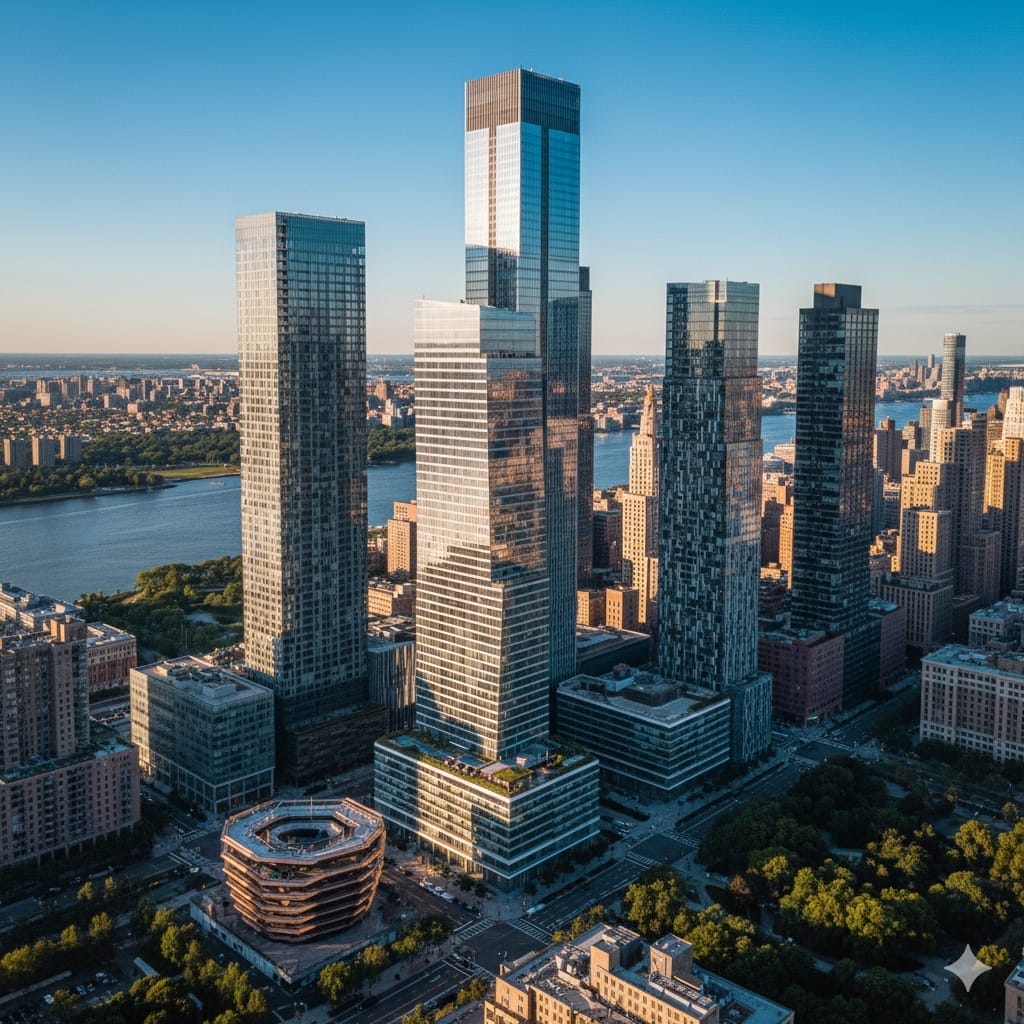
The most expensive neighborhoods in NYC are Hudson Yards ($5.95 million median), TriBeCa ($4.15 million), and SoHo ($3.69 million) as of Q2 2025 data. These Manhattan luxury enclaves represent the pinnacle of New York real estate, offering unparalleled amenities, historic architecture, and exclusive lifestyle benefits that justify their premium pricing.
New York City’s luxury real estate market reached unprecedented heights in 2025, with 39 neighborhoods surpassing the $1 million median sale price threshold. Manhattan continues to dominate the luxury landscape, claiming 23 of the top 50 most expensive neighborhoods, while Brooklyn secured an equal number of prestigious areas. This comprehensive guide examines the 15 most exclusive neighborhoods where median sale prices exceed $1.5 million, providing current market data, investment analysis, and lifestyle insights for discerning buyers.
Whether you’re a luxury home buyer, real estate investor, or simply curious about NYC’s most prestigious addresses, understanding these neighborhoods’ unique characteristics, pricing trends, and investment potential provides valuable market intelligence for navigating the city’s complex real estate landscape.
NYC Luxury Real Estate Market Analysis 2025
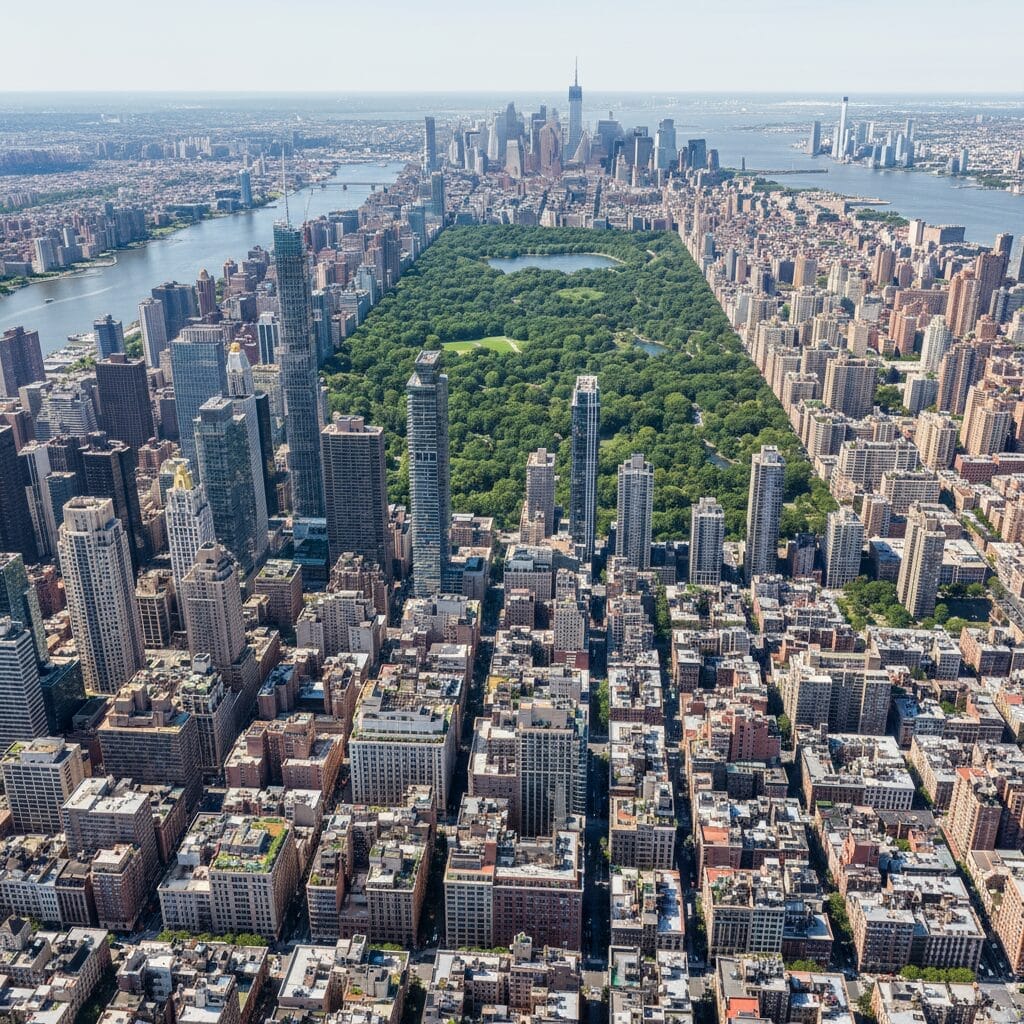
New York City’s luxury real estate market demonstrated remarkable resilience in 2025, with the overall median sale price reaching a record $799,000, representing a 4% year-over-year increase. Manhattan achieved a $1.2 million median sale price in Q2 2025, marking a new two-year high and reinforcing its position as America’s premier luxury real estate market.
Market activity remained robust with 7,118 residential transactions recorded in Q2 2025, including condos, co-ops, and single-family homes. Despite economic uncertainties, luxury buyers continued to invest in premium neighborhoods, driven by limited inventory, unique architectural offerings, and exclusive lifestyle amenities that define New York’s most prestigious addresses.
The luxury market’s strength becomes evident when examining price distribution patterns. 54 neighborhoods qualified for the top 50 ranking due to median price ties, with 39 areas exceeding the $1 million threshold. Manhattan registered one-third of all sales above the NYC median benchmark, while Brooklyn emerged as a formidable competitor with 22 neighborhoods among the city’s most expensive areas.
Luxury buyers in 2025 prioritized properties offering distinctive architectural features, building amenities, and neighborhood prestige. Co-op and condo markets showed varying performance patterns, with certain areas experiencing dramatic price increases while others demonstrated market consolidation. These trends reflect sophisticated buyer preferences and the ongoing evolution of NYC’s luxury real estate landscape.
The 15 Most Expensive NYC Neighborhoods by Median Sale Price
1. Hudson Yards – $5.95 Million Median
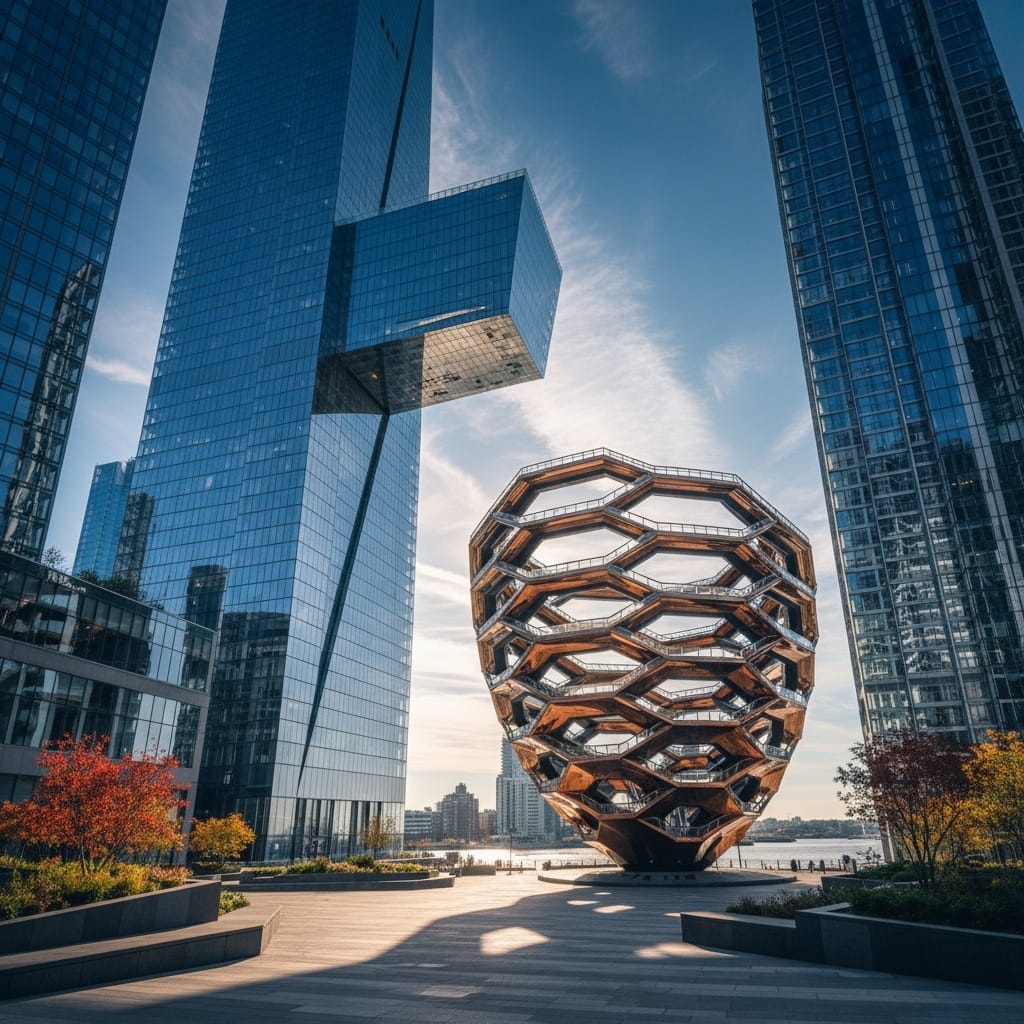
Hudson Yards maintains its position as NYC’s most expensive neighborhood with a $5.95 million median sale price, offering residents ultra-modern luxury condominiums with unparalleled Manhattan skyline views. Despite experiencing a 21% year-over-year decrease, Hudson Yards continues to attract luxury buyers seeking contemporary living spaces in Manhattan’s newest luxury district.
The neighborhood features luxury amenities, such as Edge observation deck, Vessel sculpture, and Hudson River Park access. Notable buildings include 15 Hudson Yards, 30 Hudson Yards, and 35 Hudson Yards, each offering distinctive architectural designs and premium resident services. Sales activity increased 40% year-over-year, though this represented only two additional transactions, highlighting the exclusive nature of available inventory.
Hudson Yards’ appeal stems from its integration of residential, commercial, and cultural spaces within a cohesive urban development. The neighborhood provides residents with direct access to high-end shopping at Hudson Yards Mall, world-class dining establishments, and corporate headquarters of major companies including Google and Guardian. Transportation convenience includes subway access via the 7 train at 34th Street-Hudson Yards station and proximity to Penn Station for regional connectivity.
Investment outlook remains strong due to continued development completion and infrastructure improvements. The neighborhood’s modern infrastructure, energy-efficient buildings, and comprehensive amenities package justify premium pricing for buyers prioritizing contemporary luxury living in Manhattan’s evolving West Side corridor.
2. TriBeCa – $4.15 Million Median
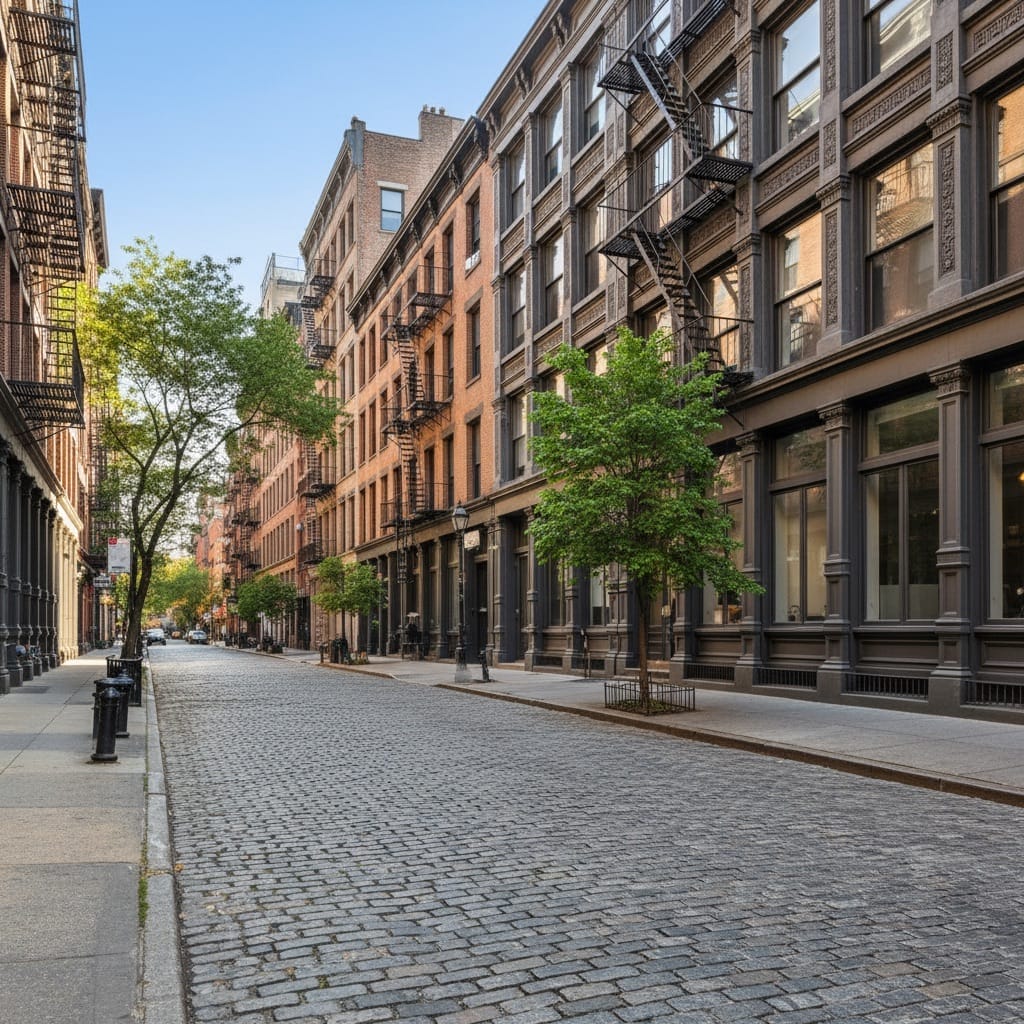
TriBeCa achieved its highest median sale price since Q2 2019 at $4.15 million, fueled by a remarkable 43% year-over-year growth that positioned it as the second most expensive neighborhood in NYC. This Triangle Below Canal Street has transformed from an industrial district into Manhattan’s premier celebrity enclave, attracting high-profile residents and luxury real estate investors.
The neighborhood recorded a 52% increase in sales activity during Q2 2025, with 80% of transactions involving condominiums compared to 68% in the previous year. Notable sales included four single condo units exceeding $10 million each, including a $16.5 million transaction at 443 Greenwich Street. The median condo sale price reached $4.35 million, significantly higher than the previous year’s $2.97 million benchmark.
TriBeCa’s architectural landscape combines historic cast-iron buildings with modern luxury developments. Residents enjoy spacious loft conversions featuring high ceilings, exposed brick walls, and oversized windows that maximize natural light. The neighborhood’s cobblestone streets, tree-lined blocks, and industrial heritage create an authentic New York atmosphere that appeals to discerning buyers seeking character-rich properties.
Location advantages include proximity to Hudson River Park, Teardrop Park, and excellent transportation connectivity through 10 subway lines serving the area. The neighborhood offers world-class dining establishments, art galleries, and the annual TriBeCa Film Festival, creating a vibrant cultural environment that supports property values and rental demand.
Investment potential remains exceptional due to limited inventory, continued celebrity interest, and the neighborhood’s established reputation as Manhattan’s most exclusive residential enclave. TriBeCa properties consistently demonstrate strong appreciation and rental yields, making them attractive to both owner-occupants and real estate investors seeking premium NYC assets.
Check out all homes for sale in Tribeca
3. SoHo – $3.69 Million Median
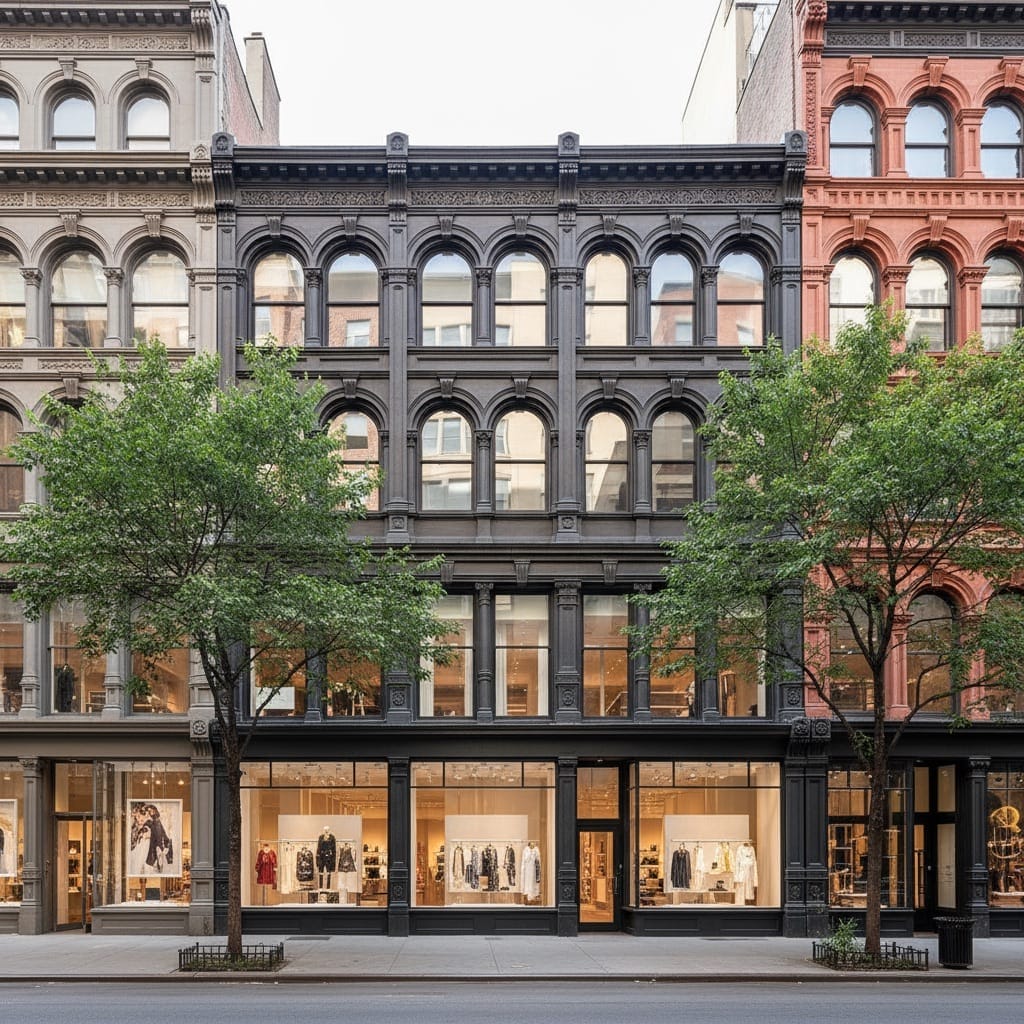
SoHo claimed the third position with a $3.69 million median sale price, representing a 19% yearly increase that reinforces its status as Manhattan’s premier shopping and cultural district. This South of Houston Street neighborhood combines world-renowned retail destinations with luxury residential offerings in historic cast-iron architecture buildings.
The neighborhood’s real estate market benefits from its dual identity as both a luxury residential area and international shopping destination. SoHo’s unique architectural character, featuring the world’s largest collection of cast-iron buildings, creates distinctive living spaces with soaring ceilings, large windows, and industrial design elements that appeal to luxury buyers seeking authentic New York living experiences.
Residential options include converted loft spaces, modern condominiums, and historic co-op buildings. Many properties feature artist live-work configurations that have been transformed into luxury residences while maintaining their creative heritage. The neighborhood’s zoning allows for flexible use patterns that support both residential and commercial activities.
SoHo’s location provides exceptional convenience for residents, with excellent transportation access through multiple subway lines including the R, W, N, Q, 6, and C trains. The neighborhood offers world-class shopping along Broadway and Spring Street, renowned dining establishments, art galleries, and cultural institutions that create a dynamic urban environment.
Investment characteristics include strong rental demand from both domestic and international tenants, consistent property appreciation, and the neighborhood’s established reputation as a global luxury destination. SoHo properties benefit from tourist interest, cultural cachet, and limited inventory that supports premium pricing and long-term value growth.
4. Little Italy – $4.59 Million Median
Little Italy emerged as a significant luxury market player with a $4.59 million median sale price during Q1 2025, after experiencing limited sales activity in previous quarters. This historic neighborhood successfully transitioned from its traditional Italian-American heritage to become one of Manhattan’s most expensive residential areas.
The neighborhood’s transformation reflects broader Lower Manhattan gentrification patterns while maintaining cultural authenticity through established Italian restaurants, specialty food shops, and annual festivals. Properties feature a mix of historic tenement buildings converted to luxury condominiums and new development projects that respect the area’s architectural heritage.
Little Italy’s compact size creates scarcity value for luxury buyers seeking authentic neighborhood character combined with Manhattan convenience. The area’s proximity to NoLiTa, SoHo, and Chinatown provides residents with diverse dining, shopping, and cultural options within walking distance.
Transportation access includes multiple subway lines serving the broader Lower Manhattan area, with Canal Street stations providing connectivity throughout NYC. The neighborhood’s central location facilitates easy access to Financial District employment centers, Brooklyn Bridge crossings, and major cultural attractions.
Investment potential benefits from the neighborhood’s authentic character, limited inventory, and increasing recognition among luxury buyers seeking unique Manhattan properties. Little Italy represents an opportunity for buyers interested in neighborhoods with strong cultural identity and appreciating real estate values.
5. NoHo – $3.5 Million Median
NoHo maintains its position among NYC’s most expensive neighborhoods with a $3.5 million median sale price, reflecting its status as an exclusive enclave North of Houston Street. This compact neighborhood offers luxury buyers authentic Manhattan living in a area renowned for its artistic heritage and architectural distinction.
The neighborhood’s real estate inventory consists primarily of converted warehouse lofts, historic townhouses, and modern condominiums. Properties often feature high ceilings with exposed beams, brick walls, and large windows that create distinctive living spaces appealing to buyers seeking character-rich homes. Notable buildings include 40 Bond, 50 Bond, 21 Astor Place, and 40 Bleecker Street.
NoHo’s cultural significance stems from its artistic legacy, including former residences of Andy Warhol and other prominent artists. The neighborhood continues to attract creative professionals and luxury buyers who appreciate its underground culture combined with upscale amenities. The Public Theater and various art galleries maintain the area’s cultural vitality.
Location advantages include excellent transportation connectivity and proximity to multiple Manhattan neighborhoods. Residents enjoy easy access to Union Square, Greenwich Village, and SoHo, creating diverse lifestyle options within a compact geographic area. The neighborhood’s central location supports both residential living and commercial activities.
Investment characteristics include limited inventory, strong demand from luxury buyers, and the neighborhood’s established reputation for property appreciation. NoHo represents an opportunity for buyers seeking authentic Manhattan character in an exclusive residential environment with excellent long-term value prospects.
6. Central Park South – $3.25 Million Median
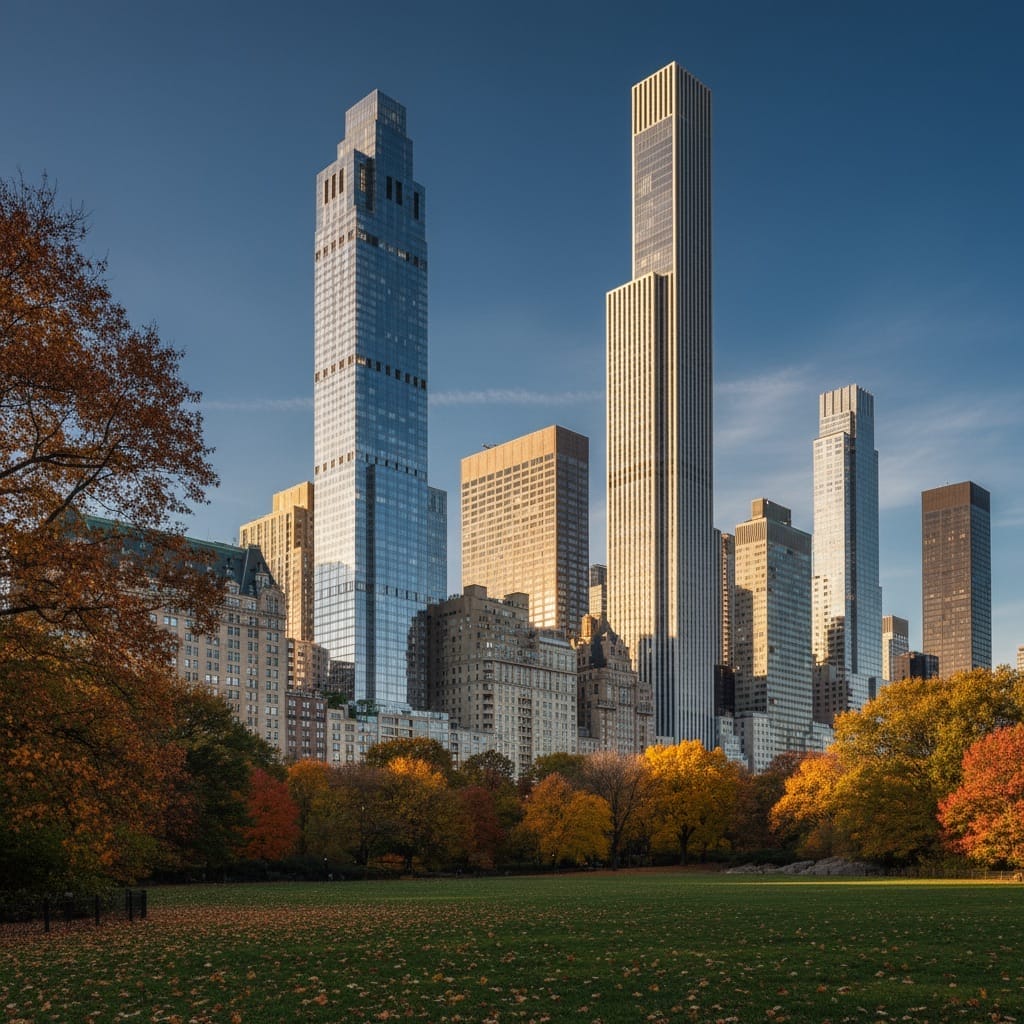
Central Park South represents Manhattan’s most prestigious address for luxury buyers seeking direct Central Park views and Fifth Avenue proximity. This iconic corridor along the southern border of Central Park commands premium pricing due to its unmatched location and access to the city’s premier green space.
The neighborhood features luxury high-rise buildings, historic hotels, and exclusive residential towers that offer residents unprecedented access to Central Park’s 843 acres of recreational space. Properties typically include doorman services, concierge amenities, and architectural details that reflect the area’s prestigious character.
Central Park South’s appeal extends beyond residential offerings to include world-class shopping along Fifth Avenue, renowned dining establishments, and cultural institutions. The area attracts international buyers and celebrities seeking Manhattan’s most recognizable luxury address with unparalleled lifestyle amenities.
Transportation convenience includes multiple subway lines and easy access to Midtown business districts. The neighborhood’s central location provides residents with excellent connectivity throughout Manhattan while maintaining the tranquil atmosphere created by Central Park proximity.
Investment potential benefits from the area’s iconic status, limited inventory, and consistent demand from luxury buyers worldwide. Central Park South properties demonstrate strong appreciation patterns and rental yields that reflect their unique combination of location, prestige, and lifestyle amenities.
7. Nolita – $3 Million Median
Nolita maintains its position among NYC’s most expensive neighborhoods with a $3 million median sale price, reflecting its evolution from a traditional Italian enclave to one of Manhattan’s chicest residential areas. This North of Little Italy neighborhood combines boutique shopping, trendy dining, and luxury residential options in a intimate village-like setting.
The neighborhood’s character results from influences by neighboring SoHo and NoHo, creating a diverse cultural and entertainment scene that appeals to luxury buyers. Tree-lined streets feature converted tenement buildings, modern condominiums, and historic townhouses that provide various housing options for discerning residents.
Nolita’s retail landscape includes vintage boutiques, designer stores, art galleries, and specialty shops that create a unique shopping environment. The neighborhood maintains its Italian heritage through established restaurants while embracing contemporary dining concepts and nightlife venues.
Location advantages include walking distance to multiple Manhattan neighborhoods and excellent transportation access. Residents benefit from proximity to Spring Street and Prince Street subway stations and easy connectivity throughout Lower Manhattan.
Investment characteristics include strong rental demand, property appreciation potential, and the neighborhood’s established reputation among luxury buyers. Nolita represents an opportunity for investors seeking authentic Manhattan character in a rapidly appreciating residential market.
8. Theatre District – $2.97 Million Median
The Theatre District commands a $2.97 million median sale price as Manhattan’s entertainment capital, offering residents immediate access to Broadway shows, world-class dining, and Times Square energy. This Midtown location attracts luxury buyers seeking urban excitement combined with residential convenience.
The neighborhood’s real estate market benefits from new development activity and luxury condominium projects that cater to buyers prioritizing location and lifestyle amenities. Properties often feature modern amenities, building services, and architectural designs that complement the area’s commercial vitality.
Theatre District living provides residents with unmatched cultural access, including Broadway theaters, comedy clubs, music venues, and entertainment attractions. The neighborhood’s 24-hour energy creates a dynamic urban environment that appeals to buyers seeking Manhattan’s most vibrant residential experience.
Transportation convenience includes multiple subway lines, bus routes, and Penn Station proximity for regional connectivity. The neighborhood’s central location facilitates easy access to business districts, cultural attractions, and dining establishments throughout Manhattan.
Investment potential reflects the area’s tourism appeal, rental demand from business travelers, and continued development activity. Theatre District properties benefit from the neighborhood’s established entertainment industry presence and ongoing urban revitalization efforts.
9. West Village – $2.8 Million Median
The West Village maintains its reputation as Manhattan’s most charming neighborhood with a $2.8 million median sale price, offering luxury buyers historic brownstones, tree-lined streets, and Village atmosphere. This Greenwich Village section provides authentic New York living with small-town character within Manhattan’s urban environment.
The neighborhood’s architectural heritage includes 19th-century townhouses, converted carriage houses, and low-rise apartment buildings that create intimate residential streets. Properties often feature original details, private gardens, and unique layouts that appeal to buyers seeking character-rich homes with modern amenities.
West Village lifestyle combines neighborhood restaurants, independent shops, art galleries, and cultural venues that support community engagement. Washington Square Park serves as the area’s cultural center, hosting events, performances, and recreational activities that enhance residential appeal.
Location advantages include excellent transportation access through multiple subway lines and proximity to other desirable Manhattan neighborhoods. Residents enjoy walking distance to SoHo, TriBeCa, and Midtown, creating diverse lifestyle options within a compact area.
Investment characteristics include consistent property appreciation, strong rental demand, and the neighborhood’s established reputation among luxury buyers. West Village properties demonstrate resilience during market fluctuations and continue to attract discerning buyers seeking authentic Manhattan living experiences.
10. Bowery – $2.35 Million Median
The Bowery has transformed into a luxury residential destination with a $2.35 million median sale price, reflecting dramatic neighborhood evolution from its historic character to contemporary urban living. This Manhattan’s oldest street now features luxury condominiums, upscale dining, and cultural attractions that appeal to modern buyers.
The neighborhood’s real estate inventory includes converted industrial buildings, new construction projects, and historic properties that have been renovated for luxury residential use. Development activity focuses on creating modern living spaces while respecting the area’s architectural heritage and cultural significance.
Bowery’s cultural renaissance includes art galleries, performance venues, trendy restaurants, and nightlife establishments that create a dynamic residential environment. The neighborhood attracts creative professionals and luxury buyers who appreciate its artistic heritage combined with contemporary amenities.
Location advantages include proximity to SoHo, NoHo, and East Village, providing residents with diverse neighborhood options and excellent transportation connectivity. The area’s central Lower Manhattan position facilitates easy access to business districts and cultural attractions.
Investment potential benefits from ongoing neighborhood transformation, development activity, and increasing recognition among luxury buyers. Bowery properties represent opportunities for buyers seeking emerging luxury markets with strong appreciation potential and authentic Manhattan character.
11. Hudson Square – $2.6 Million Median (Q1) / $1.85 Million (Recent)
Hudson Square experienced significant market volatility with median prices ranging from $2.6 million in Q1 2025 to $1.85 million in recent quarters, reflecting the dynamic nature of this emerging luxury market. The neighborhood represents Manhattan’s newest luxury district, offering modern amenities and Hudson River proximity.
The area’s transformation from industrial use to luxury residential development creates opportunities for buyers seeking contemporary living spaces with modern amenities. New construction projects focus on creating high-end condominiums with river views, building services, and lifestyle amenities that appeal to luxury buyers.
Hudson Square’s location provides residents with Hudson River Park access, waterfront recreation, and proximity to TriBeCa and SoHo. The neighborhood benefits from ongoing development activity and infrastructure improvements that enhance residential appeal.
Transportation access includes subway connectivity and easy access to other Manhattan neighborhoods. The area’s position near major transportation hubs facilitates commuting throughout NYC and regional destinations.
Investment considerations include market volatility, development pipeline effects, and the neighborhood’s emerging status among luxury buyers. Hudson Square represents an opportunity for buyers interested in Manhattan’s evolving luxury landscape with potential for long-term appreciation.
12. Greenwich Village – $1.6 Million Median
Greenwich Village maintains its position as a $1.6 million median neighborhood, offering luxury buyers historic charm, cultural significance, and Village lifestyle in Manhattan’s most beloved residential area. The neighborhood combines residential tranquility with urban convenience in an authentic New York setting.
The area’s real estate market features historic townhouses, converted apartment buildings, and small-scale condominiums that preserve neighborhood character while providing modern amenities. Properties often include original architectural details, private outdoor space, and unique layouts that reflect the area’s historic development patterns.
Greenwich Village cultural attractions include Washington Square Park, comedy clubs, jazz venues, and independent theaters that create vibrant community life. The neighborhood’s artistic heritage and bohemian character continue to attract residents seeking authentic Manhattan living experiences.
Location advantages include excellent transportation connectivity and proximity to multiple Manhattan neighborhoods. Residents benefit from subway access, walkability to business districts, and the neighborhood’s central position within Manhattan’s cultural landscape.
Investment characteristics include stable property values, consistent rental demand, and the neighborhood’s established reputation among buyers seeking Manhattan character. Greenwich Village properties demonstrate long-term value retention and appeal to both domestic and international luxury buyers.
13. Cobble Hill (Brooklyn) – $1.84 Million Median
Cobble Hill represents Brooklyn’s entry into NYC’s most expensive neighborhoods with a $1.84 million median sale price, reflecting the borough’s emergence as a luxury real estate destination. This Brooklyn Heights adjacent neighborhood offers Manhattan proximity with residential character and family-friendly amenities.
The neighborhood features historic brownstones, converted townhouses, and modern condominiums that provide diverse housing options for luxury buyers. Properties often include private gardens, original architectural details, and spacious layouts that appeal to families and professionals seeking Brooklyn living with Manhattan access.
Cobble Hill’s community character includes tree-lined streets, neighborhood restaurants, independent shops, and Cobble Hill Park that create village atmosphere within Brooklyn’s urban environment. The area attracts residents seeking neighborhood community combined with luxury amenities.
Transportation convenience includes multiple subway lines providing direct Manhattan access in 15-20 minutes. The neighborhood’s proximity to Brooklyn Bridge Park and Brooklyn Heights Promenade offers residents recreational options and spectacular Manhattan skyline views.
Investment potential benefits from Brooklyn’s continued gentrification, Manhattan proximity, and the neighborhood’s established reputation among luxury buyers. Cobble Hill properties demonstrate strong appreciation and represent opportunities for buyers seeking Brooklyn luxury with Manhattan convenience.
14. Chelsea – $1.68 Million Median
Chelsea achieved a $1.68 million median sale price with the most active sales market recording 175 transactions in recent quarters. This Midtown Manhattan neighborhood offers luxury buyers art gallery district character combined with modern amenities and excellent transportation connectivity.
The neighborhood’s real estate inventory includes converted industrial buildings, modern condominiums, and historic townhouses that reflect Chelsea’s evolution from industrial use to luxury residential destination. Development activity focuses on creating contemporary living spaces while maintaining neighborhood character.
Chelsea’s cultural attractions include High Line Park, Chelsea Market, art galleries along 22nd-27th Streets, and diverse dining establishments that create dynamic residential environment. The neighborhood attracts creative professionals and luxury buyers who appreciate its artistic heritage.
Location advantages include excellent subway connectivity through multiple lines and proximity to Midtown business districts. Chelsea Piers provides recreational facilities, while the neighborhood’s central location facilitates access throughout Manhattan.
Investment characteristics include strong rental demand, ongoing development activity, and the neighborhood’s established position in Manhattan’s luxury market. Chelsea properties benefit from the area’s cultural appeal and continued urban development initiatives.
15. DUMBO (Brooklyn) – $1.88 Million Median
DUMBO rounds out the top 15 with a $1.88 million median sale price, representing Brooklyn’s premier luxury neighborhood with Manhattan Bridge and Brooklyn Bridge proximity. This Down Under Manhattan Bridge Overpass area combines historic architecture with modern development and spectacular waterfront views.
The neighborhood’s real estate market features converted warehouse buildings, modern condominiums, and luxury rental buildings that offer residents industrial character with contemporary amenities. Properties often include exposed brick, high ceilings, and oversized windows that maximize natural light and architectural character.
DUMBO’s location provides residents with Brooklyn Bridge Park access, waterfront recreation, and unparalleled Manhattan skyline views. The neighborhood offers cultural attractions including art galleries, performance venues, and the annual DUMBO Arts Festival that enhance community vitality.
Transportation convenience includes subway connectivity to Manhattan and excellent walkability to Brooklyn Heights and other desirable Brooklyn neighborhoods. NYC Ferry service provides scenic commuting options to Manhattan destinations.
Investment potential benefits from the neighborhood’s waterfront location, continued development activity, and established reputation among luxury buyers seeking Brooklyn living with Manhattan views. DUMBO properties demonstrate strong appreciation and rental yields that reflect their unique combination of location and lifestyle amenities.
Investment Strategies for NYC’s Most Expensive Neighborhoods
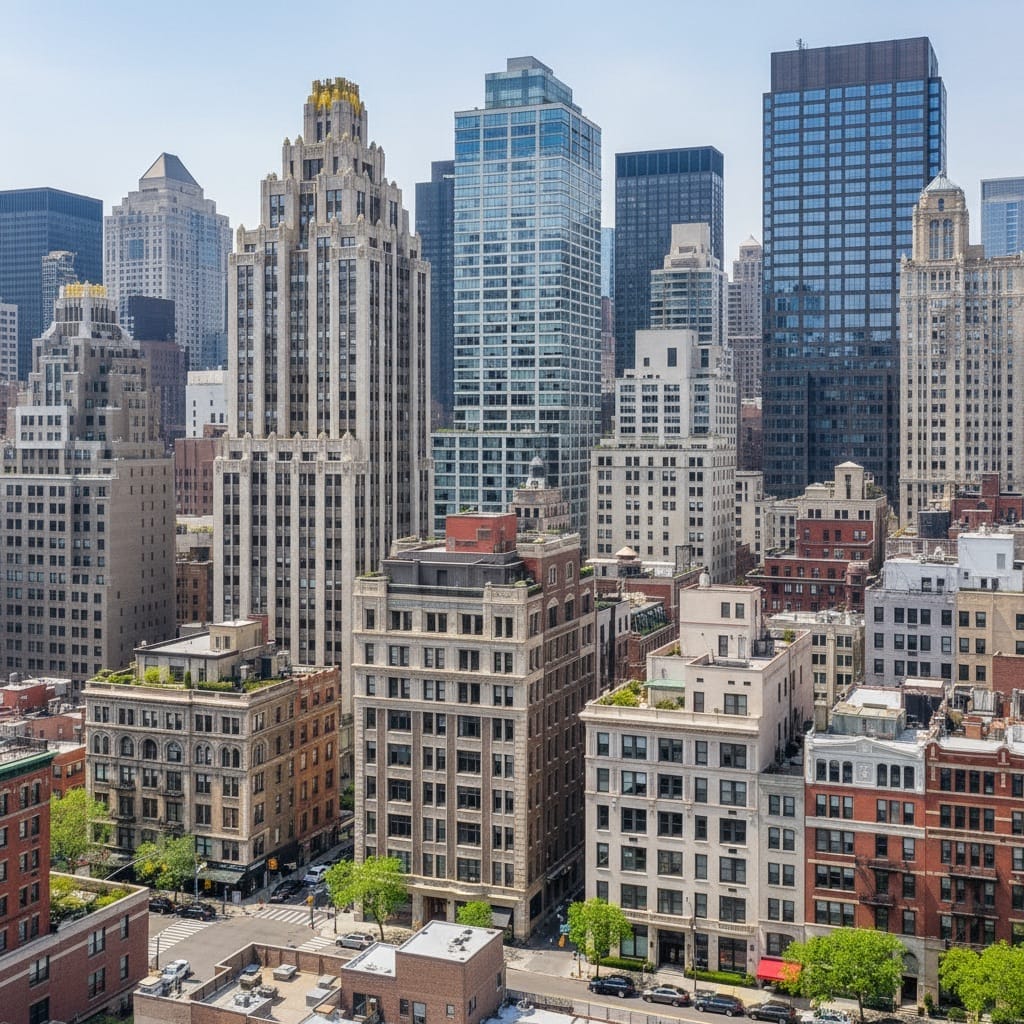
Investing in NYC’s most expensive neighborhoods requires sophisticated financial planning and market knowledge to navigate luxury real estate complexities successfully. Purchase prices exceeding $1 million trigger NYC mansion tax obligations that significantly impact transaction costs and investment returns for luxury buyers.
The NYC mansion tax ranges from 1% to 3.9% depending on purchase price, with properties in neighborhoods like Hudson Yards and TriBeCa typically falling into higher tax brackets. Buyers must budget for these additional costs when calculating investment returns and financing requirements for luxury purchases.
Financing luxury properties often requires 20-25% down payments, debt-to-income ratios below 28%, and specialized lending programs through private banks that understand high-net-worth client needs. Luxury buyers benefit from establishing relationships with private banking institutions that offer portfolio lending, jumbo mortgages, and flexible underwriting criteria for complex financial situations.
Co-op purchases in expensive neighborhoods involve additional considerations including board approval processes, financial disclosure requirements, and maintenance fee structures that differ significantly from condominium ownership. Understanding HOA vs co-op fees helps buyers evaluate total ownership costs and make informed decisions about property types and neighborhood selections.
Investment returns in luxury neighborhoods depend on rental yield potential, property appreciation patterns, and neighborhood development trends. Areas experiencing significant development activity, such as Hudson Yards and Hudson Square, offer potential appreciation upside but may experience market volatility during construction phases.
Tax considerations for luxury property ownership include property tax assessments, mortgage interest deductions, and potential 1031 exchange opportunities for investment properties. Buyers should consult with real estate attorneys and tax professionals who understand luxury market complexities and can structure transactions to optimize financial outcomes.
Portfolio diversification strategies may include combining luxury properties with more affordable investments to balance risk and return potential. Some investors pursue multi-unit buildings or emerging neighborhoods that offer growth potential while maintaining exposure to established luxury markets.
Lifestyle Benefits of NYC’s Most Expensive Neighborhoods
Living in NYC’s most expensive neighborhoods provides residents with enhanced lifestyle experiences, increased social prestige, and improved quality of life through exclusive amenities and cultural access that justify premium pricing for discerning buyers.
Dining and Entertainment options in luxury neighborhoods include Michelin-starred restaurants, exclusive private clubs, and world-class cultural venues that create sophisticated social environments. TriBeCa restaurants like Nobu and Locanda Verde attract celebrity clientele, while Hudson Yards offers Thomas Keller’s TAK Room and other high-end dining establishments.
Cultural Attractions provide residents with immediate access to Broadway theaters, art galleries, music venues, and museums that enhance daily living experiences. SoHo’s gallery district, NoHo’s Public Theater, and proximity to Lincoln Center create rich cultural environments that support intellectual and artistic engagement.
Shopping and Retail access includes luxury boutiques, designer flagship stores, and exclusive shopping destinations that cater to affluent clientele. SoHo’s international retail presence, Hudson Yards Mall, and proximity to Fifth Avenue shopping provide residents with convenient access to world-class retail experiences.
Parks and Recreation facilities offer urban oasis experiences through Central Park access, Hudson River Park, and neighborhood green spaces that provide recreational opportunities and natural beauty within Manhattan’s urban environment. Waterfront neighborhoods like DUMBO and Hudson Yards offer running paths, cycling routes, and outdoor recreation that enhance healthy living options.
Educational Institutions in luxury neighborhoods often include top-rated public schools, prestigious private academies, and proximity to universities that support family living and educational excellence. Areas like the Upper East Side and Greenwich Village provide access to elite educational institutions that enhance property values and family lifestyle quality.
Building amenities in luxury neighborhoods typically include 24-hour doorman service, concierge assistance, fitness centers, rooftop terraces, and private dining rooms that create resort-like living experiences. Modern developments offer swimming pools, spa facilities, children’s playrooms, and business centers that eliminate the need for external services.
Security and privacy features in expensive neighborhoods include advanced building security systems, private elevators, and discrete entrance options that appeal to high-profile residents seeking confidential living arrangements. Many luxury buildings employ former law enforcement professionals and maintain strict visitor protocols.
Transportation Access from Most Expensive Neighborhoods in NYC
Luxury neighborhood residents benefit from superior transportation connectivity that facilitates efficient commuting throughout NYC and regional destinations, justifying premium housing costs through time savings and convenience factors.
Subway Access from expensive neighborhoods typically includes multiple train lines, express service options, and reduced commute times to major business districts. TriBeCa offers 10 subway lines with Franklin Street station providing 11-minute access to Times Square and 14-minute connectivity to Union Square. Hudson Yards’ 7 train station offers direct access to Grand Central and other Manhattan destinations.
Ferry Transportation provides scenic commuting alternatives through NYC Ferry routes connecting waterfront neighborhoods to Manhattan employment centers. DUMBO residents access $4.50 ferry service to Wall Street/Pier 11 and East 34th Street, while West Side neighborhoods benefit from Hudson River ferry connections to Midtown and Lower Manhattan.
Taxi and Ride-Share costs from luxury neighborhoods typically range $15-35 for Manhattan destinations and $25-50 for outer borough travel, providing convenient door-to-door transportation for residents prioritizing comfort and time efficiency. Peak hour pricing and availability remain consistently reliable in expensive neighborhoods.
Parking Availability varies significantly among luxury neighborhoods, with monthly garage rates ranging from $300-600 in Manhattan locations. Some luxury buildings offer resident parking programs or valet services that simplify car ownership for residents who prefer private transportation options.
Regional Transportation access includes Penn Station proximity from Midtown neighborhoods, Grand Central access from Upper East Side locations, and PATH train connectivity from Hudson Yards to New Jersey destinations. These connections facilitate regional business travel and weekend recreation outside NYC.
Airport Connectivity from expensive neighborhoods benefits from professional car services, helicopter transfers, and express transportation options that reduce travel time to JFK, LaGuardia, and Newark airports. Many luxury buildings maintain relationships with transportation providers who offer premium airport services.
Walking and cycling infrastructure in luxury neighborhoods often includes protected bike lanes, pedestrian-friendly streets, and proximity to recreational paths like the High Line, Hudson River Greenway, and Central Park loop roads that support healthy commuting alternatives.
Future Development Impact on NYC’s Most Expensive Neighborhoods
Planned development projects and infrastructure improvements will significantly influence property values and neighborhood character in NYC’s most expensive areas over the next decade, creating both opportunities and challenges for luxury real estate investors.
Hudson Yards Phase 2 development includes additional residential towers, office buildings, and retail spaces that will complete the neighborhood’s transformation into Manhattan’s largest private real estate development. Completion of remaining projects may stabilize pricing while increasing available inventory for luxury buyers.
Lower Manhattan Resilience projects include flood protection infrastructure, waterfront improvements, and climate adaptation measures that protect expensive neighborhoods like TriBeCa and SoHo from future environmental challenges. These investments support long-term property value protection and insurance cost management.
Transportation Infrastructure improvements include Second Avenue Subway extension, Penn Station renovation, and improved ferry service that will enhance connectivity from expensive neighborhoods to business districts and regional destinations. Better transportation access typically supports property appreciation in luxury markets.
Zoning Changes in neighborhoods like SoHo and NoHo may allow increased residential development, mixed-use projects, and building height modifications that could affect neighborhood character and property values. Understanding proposed zoning modifications helps investors anticipate market changes and investment opportunities.
Climate Adaptation requirements for waterfront neighborhoods include building resilience standards, flood-resistant infrastructure, and environmental compliance measures that may increase development costs but protect long-term property values. Luxury buyers increasingly prioritize sustainable building features and climate preparedness.
Cultural Institution expansions and new developments enhance neighborhood appeal and property values through museum projects, performance venues, and educational facilities that create cultural anchors supporting residential demand. Areas near Lincoln Center, Museum Mile, and emerging cultural districts benefit from institutional investment.
Development pipeline analysis reveals luxury inventory increases in certain neighborhoods that may moderate price growth while providing buyers with more options. Understanding supply trends helps investors time purchases and select neighborhoods with favorable supply-demand dynamics.
Frequently Asked Questions About NYC’s Most Expensive Neighborhoods
What is the most expensive neighborhood in NYC 2025?
Hudson Yards is the most expensive neighborhood in NYC with a median sale price of $5.95 million as of Q2 2025. Despite experiencing a 21% year-over-year decrease, Hudson Yards maintains its position as Manhattan’s premier luxury district due to ultra-modern amenities, architectural distinction, and prime West Side location.
How much does it cost to live in TriBeCa?
TriBeCa has a median sale price of $4.15 million and average rental costs of $6,586 per month for apartments. The neighborhood experienced a remarkable 43% year-over-year price increase, making it the second most expensive area in NYC with luxury condominiums typically selling for over $4 million.
Which NYC neighborhoods are good investments?
TriBeCa, SoHo, and Hudson Yards offer strong investment potential due to limited inventory, consistent demand from luxury buyers, and established track records of property appreciation. These neighborhoods demonstrate resilience during market fluctuations and attract both domestic and international investors seeking premium NYC real estate.
What makes Hudson Yards so expensive?
Hudson Yards commands premium prices due to ultra-modern luxury condominiums, world-class amenities including Edge observation deck, and prime Manhattan location with exceptional skyline views. The neighborhood’s new construction standards, building services, and proximity to corporate headquarters justify median prices approaching $6 million.
Are NYC luxury neighborhoods worth the investment?
NYC luxury neighborhoods typically provide strong long-term appreciation, rental income potential, and lifestyle benefits that justify premium pricing for qualified buyers. Historical data shows consistent value growth in established neighborhoods, though buyers should consider NYC mansion tax implications and total ownership costs.
How do I finance a luxury NYC apartment?
Luxury NYC financing typically requires 20-25% down payments, debt-to-income ratios below 28%, and specialized lending programs through private banks. Buyers benefit from establishing relationships with institutions offering portfolio lending, jumbo mortgages, and flexible underwriting for high-net-worth clients with complex financial situations.
Understanding the New York City metropolitan area housing market provides valuable context for luxury neighborhood investments. Whether you’re considering building versus buying or exploring alternatives like Brooklyn neighborhoods, working with experienced real estate professionals ensures successful navigation of NYC’s complex luxury market.
Contact Robert DeFalco Realty’s luxury specialists to explore exclusive listings in NYC’s most prestigious neighborhoods and receive expert guidance for your luxury real estate investment or purchase decision.
